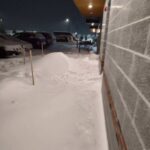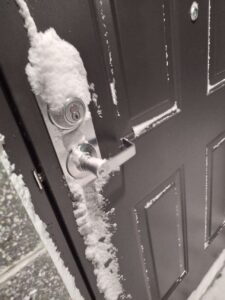by Winding Pathways | Aug 18, 2022 | Reflections/Profiles
We’re not normally pet people. Never had a dog or cat. When our children were growing up, we had bunnies. After they grew up and left home years ago, we cared for the bunnies left over from their youth and adopted a couple from Kirkwood Community College in the early 2010s. When the last bunny died in 2015, we were petless and had no intention of adopting an animal.
Oreo Comes to Our House
Then, a call came just as the pandemic gained strength in early 2020. A family was moving out of state and couldn’t bring Oreo, their pet rabbit, along. Would we take her in? It looked like we’d be confined to home to stay disease safe, so we said, “Yes”.
Oreo was an indoor bunny and came complete with the hutch, food, and supplies. Soon she settled into her comfortable hutch in our den near where Marion does office work. She did more. We quickly learned she’s smart, funny, clean, inquisitive, and a good friend.
Smart
She learned to go “Into the hutch” with some treats inside. Sometimes she led us on a merry chase around the den before she hopped in. Under the table, into her habitat, under the desk, under the heater, behind the trash bin, and back under the table. All along we said quietly, “Into the hutch.”
We tried to encourage her to chew on wood in the hutch (not furniture and doors!) by rubbing yogurt treats on the wood. Well, she learned to lick off the flavor instead of chewing the wood we gave her.
We often sat on the back deck in mild weather and even on nice winter days. To keep bugs out we hung a temporary screen at the back door that closed with magnets. Oreo quickly learned to nose under the screening to go in or out at will when we sat outside.
Clean Office Assistant
She’d roar out of her hutch in the morning and park by the computer grooming herself. She spent much of the day resting on the floor by the desk when Marion typed, and we soon called her our able office assistant. Every so often she’d stretch and want attention. She’d nudge Marion’s pant leg with her nose for a scratch behind the ears and rub under the chin. If that didn’t work, she’d scratch the pant leg. If THAT didn’t work, she’d thump. That usually got the attention she wanted.
Digger!
She’d romp around the deck while we were reading the morning paper and gleefully dig in a sandbox that we created for her. Rich would dangle his arm low and she’d come over for a rub. He’d switch hands to the other side of the chair and Oreo was right there for continued love. Each evening was “treat” time. A Russell’s Rabbit orange or green “cookie.” Rich broke it into pieces and Oreo would grab a piece and hope two feet away and nibble on it, then return for more pieces. We learned, don’t even think about patting her while she was eating!
Did You Know Rabbits Vocalize?
She vocalized with a growl if annoyed and when nervous or upset she squeaked.
Loyal Friend
This past year, when we left for a few days and neighbors watched her they reported that she stood up on her hind legs, looked around, and seemed to wonder, “Where are they?” Because she could see us go up and down the stairs evenings and mornings from her hutch, she learned we disappeared up there. So when we were gone, she even went to the foot of the stairs and looked up wondering, “Are they there?”
During the pandemic, she gave us laughs and companionship. She was a fun companion. So, fun that perhaps we didn’t recognize how much a part of our lives she’d become.
Saying Goodbye
Although only about five years old, one morning we found much blood in her hutch that came from urine and, perhaps, her intestines. Concerned, we took her to Bright Eyes and Busy Tails in Iowa City.
Their staff were kind and knowledgeable and confirmed that the blood was caused by an unknown internal problem. They could do tests and maybe take action. Surgery perhaps. “What did we want to do?” they asked. We talked it over and rejected intensive testing and possible resulting, expensive, and uncomfortable techniques. Actions that would ultimately result in the same ending. Sadly, we requested euthanasia for our friendly Oreo. It was done peacefully and painlessly while we held her and sang her special “Oreo Song” that Marion sang to her several times a day while scratching behind her ears and rubbing under her chin.
Part of the Prairie
That afternoon we buried Oreo beneath the wildflowers of our prairie, along with the other bunnies. But, sadness lingers. We miss her. We talk with her in the spot where her hutch once was. We visit her grave.
We know the sadness will fade over time and we’ll glance at her photos occasionally. Mostly we feel gratitude for the time she shared her life with us. And all the bunnies our family has had as friends. We posted a Salute to Bunnies on YouTube.
The Oreo Song
“Oreo the bunny, you’re so funny. Oreo the bunny 1, 2, 3.
Oreo the bunny, the black and white bunny, You came to live with Rich and me.
You have two black ears and two black eyes and black spots down your back.
You have a black and white nose and four white paws that go clickity clack
On the deck or on the dining room floor when you go to explore.
Oftener than not, you stretch right out by the threshold door.
You’re a good little friend. You came to our house. You came to live with us.
You run around. You “binky”. Sometimes you thump. Then, you’re quiet as a mouse.”
Be well, Spirit of Oreo, and all loved pets everywhere.
-

-
Part Lion’s Head and maybe rex
-

-
Nibbling coneflowers.
-

-
Digging outside.
-

-
Cleaning up after.
-

-
Making Derecho wood useful.
-

-
Oreo the Office Assistant.
-

-
Daily news.
-

-
Oreo tolerated being picked up…
-

-
Waiting by the threshold door.
-

-
Oreo the bunny.
by Marion Patterson | Jun 2, 2022 | Chickens, Garden/Yard, Geology/Weather, Hoover's Hatchery, Preparedness, Reflections/Profiles, Travel/Columns
Coming up to a year from the last post on the features we wrote for the Cedar Rapids Gazette, here is an updated list for the second half of 2021 and the first half (almost) of 2022. These features are in addition to our regular work with Hoover’s Hatchery blogs and FB Live and our own blogs for Winding Pathways.
May 8, 2022. Splish Splash! Whitewater Kayaking in Iowa. (No link to date)
April 22, 2022. Finding America On Roadways East.
April 13, 2022. Muscle Over motor When Boating.
March 21, 2022. Rockhounding.
January 30, 2022. Backpacking Bonus. (8B of GZ. No link to date) Available Green Gazette.
January 24, 2022. Distinctive Religious Structures.
January 16, 2022. Hiking Wild Areas. (no link to date) Available Green Gazette.
December, 2021. Country Schools. (no link to date) Available Green Gazette
November 15, 2021. Making a (Mini) Pitch for Soccer.
October 6, 2021. A visit with Midwest’s Pioneering Authors.
September 8, 2021. Taking a Slow Boat to Cassville.
September 6, 2021. Camping in Iowa’s Trout Country & Decorah’s Celebrities.
August 4, 2021. Parking While Headed East. And Solar Panels at Peoples.
by Winding Pathways | Apr 14, 2022 | Preparedness, Reflections/Profiles
Both Marion and Rich at Winding Pathways are regular blood donors. Rich will reach a milestone in early April. He’ll give his 100th unit of blood to Impact Life in Cedar Rapids. Marion’s not far behind.
Giving blood is easy, costs nothing, and is a way we can help other people. Here are some interesting blood donation facts:
- An average donation is used to help three people, so Rich’s 100 donations have helped around 300 people and maybe saved some lives.
- A unit of blood averages about 500 milliliters, or a little more than a pint. Rich’s have averaged about 528 ml, so he’s given about 112 gallons over decades of giving.
- A person has 1.2 to 1.5 gallons of blood in their body, and a donation takes about 10% of it. The body replaces the lost blood. Donation centers require eight weeks between donations to allow for replenishment.
- Blood is typically given to people during surgery or for treatment of conditions like Sickle Cell Disease; to those who have suffered a trauma, like an accident; and during surgery or childbirth if needed.

Giving blood is easy. And, Marion gets a cool blood band decoration!
We hope we’ll never need blood but if we do we’ll quietly thank the unknown donor. Both Marion and Rich at Winding Pathways encourage everyone to become blood donors.
by Winding Pathways | Mar 31, 2022 | (Sub)Urban Homesteading, Chickens, Reflections/Profiles
Keep the Photos!
An old photo or letter can bring back memories. That happened to Rich recently and helped him recognize both good parenting and a lifelong passion.
Rich was sorting through a stack of family documents when he discovered a paper his mother wrote in his “baby” book. Written in 1959, when Rich was nine, it stated that he wanted to be a chicken farmer! Of all things for a kid growing up in suburban New Jersey to say.
Rich became fascinated with chickens while only four or five years old. By the time his mother wrote in the book he had learned many chicken breeds. Another letter, dated May 5, 1959, was written as an exercise in his elementary school. The teacher was teaching students letter writing. Rich’s note to his mother said:
Thank you for taking me to the chicken farm. Now I know what a black hen looks like. I now know why one costs more than a Leghorn. I’m going to cook breakfast for you. Happy Mother’s Day. Love, Rich
A Budding Entrepreneur
A third document is an account of how many eggs his hens laid each day and a bill presented to a customer. 65 cents for a dozen in 1960. Adjusted for inflation that dozen would cost $6.50 today.
-

-
Dreaming of the future
-

-
Expressing appreciation
-

-
Learning math and writing.
A pair of photos show 13-year-old Rich at his junior high school science fairs. One science project was titled, The Effect of Vitamin E on the Hatchability of Chicken Eggs, and the other demonstrated an incubator.
-

-
A science project
-

-
Scientific studies.
What Do These Documents Signify?
- Great parenting. It must have seemed weird to his parents that their young child had such an unusual passion, but they helped, learned, and encouraged.
- Chickens helped teach math, animal care, writing, business, and research methods.
- Chickens became a lifelong passion.
Rich encourages parents to encourage their children’s passions. They might lead to lifelong hobbies and, perhaps, even a career.
Update on Careers
Rich never became a chicken farmer, per se, but he is co-owner of Winding Pathways where we encourage people to be creative in how they interact with nature and to consider backyard chicken raising. He developed another passion, fish, and earned a degree in fishery biology, and served as a biologist in Alaska.
by Winding Pathways | Feb 17, 2022 | (Sub)Urban Homesteading, Geology/Weather, Reflections/Profiles
New England’s Nor’easter January 29-20, 2022
by Susan Fellows, guest blogger
What is a Nor-easter?
Dover, NH, 4:00 a.m. Temperature 5 degrees. The wind chill is probably close to -10 degrees. Wind gusts 40-45 mph throughout the day. What is a blizzard? Wind gusts more than 35 mph. Snow blowing and drifting. Visibility less than 1/4 mile. All more than three hours. We grew up with blizzards, know them well, and call them Nor’easters.
The description above is what I saw outside my living room window all day on January 29, 2022, in excess of eight hours. There is a large green space next to my apartment building with a stand of pine trees at the far end, where there is no snow. An area just outside my apartment going out about 20-30 feet where the wind blew the snow off all day long made it look like we had only a dusting of snow. Beyond that, snow accumulated up to 1″-2″ per hour for several hours. Most of the day, I could not see the trees which are less than a 1/4 mile away.
-

-
Strong winds swept some areas bare of snow.
-

-
The building blocked the wind.
Following the Progress of the Storm
The well-predicted storm made its way up the coast from South Carolina, past Washington, DC, Philadelphia, and New York to New England. Snowfall reported in Bridgewater, MA, totaled 32″! Out at Wellfleet on the south side of Cape Cod, wind gusts reached 82 mph. Fortunately, in Dover, NH, we weren’t hit with as much snow and wind gusts were in the 40 mph range. Most of the day and into the evening I watched snow blowing horizontally past the windows. Whiteout! An all-day blizzard.
Venturing Out

Opening the door was difficult
7:30 p.m. I decided to get my mail if there was any. True to the USPO motto, through rain, wind, snow, and dark of night the Post Office did deliver the mail! Getting out my door was difficult as the snow had accumulated to about three feet. So, it was hard to open the door. Along the sidewall of the building I trudged. Not as much snow there. But, once I reached the lobby door, I had to get to the security post to swipe my key fob to open that door. Snow spilled into my boots and I had to shove the door open about a foot to squeeze through. After picking up my mail, I made my way back to my apartment.
Manager & Snow Crews Respond to Safety Concern
The snowfall seemed to be easing up but it was hard to tell as the wind still picked up and carried snow horizontally past my window. Remembering that some Eastern big cities had had fires in apartments recently, I was concerned with conditions by the exit doors. So, I called the answering service of the apartment complex. Shortly our maintenance supervisor returned my call. I explained the situation and my concern that in case of an emergency requiring evacuation of the building the other residents might not be able to get safely out. He replied that the snow removal team would return the next morning. After some discussion, with the supervisor being unrelenting with his statement that the team would be back in the morning, I simply asked who would be liable if an evacuation were needed and people could not safely get out. Then, I hung up.
Soon after the property manager called, respected the fact that I was observing the conditions and he wasn’t. He called the supervisor of the snow removal team. Within the hour they arrived! I was relieved!
Blindingly Beautiful
Sunday, January 30, 2022. The day dawned bright and beautiful! What a change from not being able to see because of the blizzard! People were out with their pets and children enjoying the light, fluffy snow. The snow removal team cleared the overflow lots and residents moved their cars so the parking log could be properly cleared. Gigantic piles of snow were all over the place and sidewalks, doorways, and cars cleared of the eight inches of reported snow. One town, right on the ocean about 12 miles away, got the state’s grand total of 13.5″. The wind, she kept on blowing and the temperatures were bitterly, brutally cold.
-

-
People moved their cars to help with snow removal.
-

-
The doorways are cleared of snow.
-

-
The snow removal team quickly cleared snow.
The next day, in appreciation, I called the supervisor to thank the crews for coming out in the storm and making sure residents were safe.
Prior to the storm, everyone had been told to stay off the roads, which they did. All-day Saturday, I had watched a storm tracker show from a Boston station. Indeed except for plows and utility crews restoring power, the roadways were clear of vehicles.
I LOVE SNOW and this was quite an event!
by Winding Pathways | Jan 27, 2022 | Reflections/Profiles
2021 Retrospective
At the end of last year, I regarded 2021 with a jaundiced eye. Then, I read the little gratitudes I had kept in the jar all year and realized the good that did happen and that we created. Below is a summary.
Labyrinths
The year 2020 ended with the last night walk and 2021 started with a pilgrim smudging the labyrinth bringing in good energy. That lasted all year with regular walkers in all seasons and weather and a surprise pilgrim who had found the labyrinth on the World Labyrinth Locator. The pilgrim explained she was taking on 50 new activities and adventures through her 50s years. She had learned manual skills from her dad, set out to travel safely, and now was taking in labyrinths on her cross-country trip. The Phoenix Harmony Labyrinth was one of her Iowa connections!
-

-
Teri blesses the labyrinth
-

-
January – Smudging for the new year.
Light One Candle 2.0: To honor the new administration colleagues in the Labyrinth community held a virtual service of renewal and blessing.
Church:
Peoples Church Unitarian Universalist has continued to flourish during this year of transition. People have stepped forward to serve. Board meetings run smoothly with thoughtful discussion and positive action. Members have generously contributed to projects such as the endowment that provides secure, long-term funding for our mission and the solar installation. Before the solar, we upgraded fixtures, replaced inefficient bulbs, and re-roofed. Even in the dark of the year, the electric bill plummeted from $300 in one month to $20 the next month.
-

-
Peoples church installed solar panels after roof repairs and upgrading lights and HVAC.
-

-
Peoples offered performance opportunities for young musicians.
Friends:
Once we figured out how to socialize safely, we had occasional outings with friends, over for an outdoor meal, helping with bucking up wood. Rich took our young friend P fishing. They completed a survey at Big Dick Lake and submitted a report/scientific paper to Dr. Morris at ISU. Pretty cool for an 11-year-old. P helped place the solar lights in the labyrinth. N decided the plastic flamingos made terrific steads to ride. Periodically, I would find the “birds” in different locations around the labyrinth and knew that N and O had come by with their mom. She hiked over on snowy days, too pulling the Littles on the sled. Intrepid! We visited in MN with cousins a couple of times being careful about health protocols and enjoying Immersive Van Gogh in the fall. ZOOM calls, Firepit Fridays, Polar Pizza, Potpie Parties….we made good things happen safely. RAGBRAI at big Dick Lake was fun to see the crazy outfits people wore as we waved them on.
-

-
Lu intrepidly visited with the Littles
-

-
You see everything on RAGBRAI
-

-
P helped document fish at Big Dick Lake
-

-
In all weather friends gathered around the fire pit.
Weather: Hot and dry. We ended with a 15” deficit so the Gratitudes of the occasional, “Quiet, drippy day” were welcome.
Long Trips, Day Trips, and Writing:
Wow! In spite of all, we managed a trip to Alaska to see N and B. Overnighting in the Hytte, birding, Turnagain Arm, the ski slope, great food, walks, the Museum all in lovely weather. Clear, calm, frosty at night, and warm in the day. Two trips east – June and Late September early October – found us exploring new areas like the Meadowcroft-Rockshelter and Flight 93 Memorial in SW Pennsylvania. A stay at Jay Peak in northern Vermont brought New England back home. New camping areas and a wonderful meal at Punderson Lodge in a terrific rainstorm. We covered a lot of ground in Iowa exploring and writing about museums, the Cassville Ferry, Sprint Cars, cemeteries, parks, and taking in amazing wall art in Dubuque.
-

-
A Dubuque must see.
-

-
Dubuque boasts many wall murals.
-

-
Wrestling Hall of Fame
-

-
Northern Vermont’s foliage season is a must see.
-

-
After a short 15 minute ferry visit Cassville, WI.
-

-
Testing skills with atlatl.
-

-
A somber experience
-

-
Oh What a Knight!
Animals:
Readers know we have chickens and produce FB Live each month with Kelsey Spotts from Hoover’s Hatchery. These are fun and we have great conversations and share a meal after the FBLive shows. We also have a rescue bunny, Oreo, who loves to dig in the sandbox we placed on the deck. She is a mess and ten minutes later she is all cleaned up. Oreo knows to nose under the mosquito netting to get onto the deck, she is Marion’s “office assistant” faithfully sitting by the desk during computer time. She ever has a song made up for her!
-

-
Chickens will forage for insects and eat vegetation all summer.
-

-
Oreo gets all dirty and 10 minutes later she is clean as a whistle.
We are well and 2021 although stressful, also had bright spots. These we remember to help us keep balance.
Welcome, 2022!








































